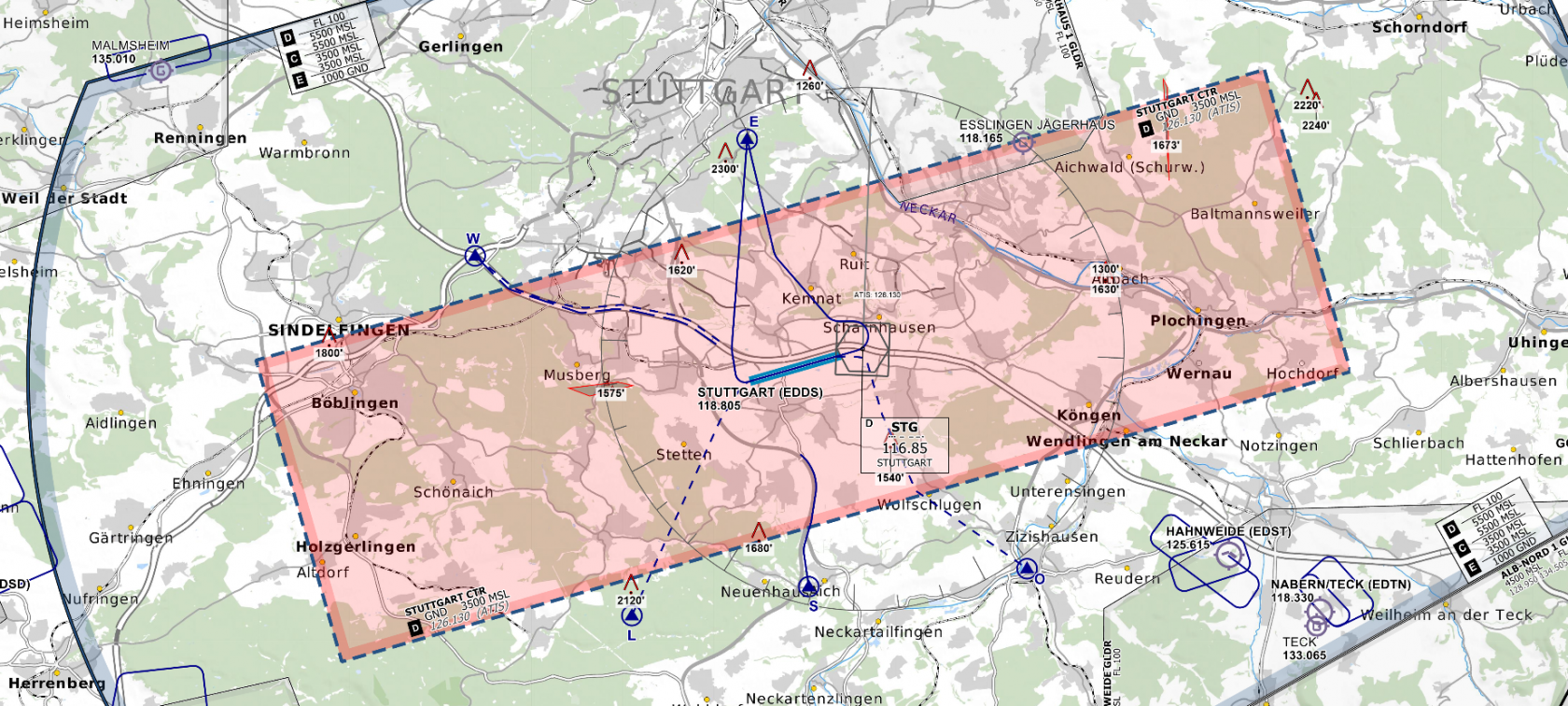Tower
Stuttgart Tower is responsible for the runway and traffic within the D control zone.
Runway in use: Runway in use is based on the direction of the wind (METAR and TAF). There is no preferred direction used in Stuttgart. In calm conditions, it is also possible to use runway 07 for departures and runway 25 for landings (opposite departure). These departures against the operating direction need a release by Arrival prior departure.startup and departure.
Taxiway Z: Taxiway Z between taxiway Y and O is controlled by Tower.Ground. During 25 operations, Ground will inform Tower of crossing traffic up to 14m height (CAT1) or up to 6m (LVP). Crossing of higher aircraft has to be coordinated and Tower has to inform aircraft on final about possible ILS interference. During CAT1 operations, the aircraft on final must be able to proceed without ILS guidance within 4 NM final and during LVP this area has to be clear when inbound traffic is within 4 NM final, otherwise the inbound aircraft has to go around.
During 07 operationsoperations, crossings are always coordinated and the area between the stopbarsstop needbars has to be free while inbound traffic is on awithin 2 NM finalfinal, (CATotherwise I)the orinbound a 4 NM final (CAT II/III). Otherwise landing trafficaircraft has to go around.around.
DLH123, expect short term ILS interference by Airbus A320 crossing on Z.
Slow Aircraft: InTo caseincrease thereefficiency, isTower acan departingutilize slowvisual departures for prop and turboprop aircraft onup ato SID5.7t (e.g.MTOM. pistonThese aircraft),have to be coordinated with Arrival and accepted by the pilot. Separation always has to be informedensured.
DEABC, advise able to accept visual departure.
| 07 North SID |
heading 350 |
| 07 South SID |
heading 160 |
| 25 North SID |
heading 340 |
| 25 South SID |
heading 200 |
ABTAL and ROTWE SIDs count as South departures.
DEABC, when airborne turn right HDG 340, maintain visual reference to the terrain until passing 3500ft, climb 5000ft, remain on tower frequency
The handoff to Arrival takes place when the aircraft passes the MVA.
Outbound
Intersection: Pilots always need always to be asked if they are able for any intersection except full length.
Bypass Area: If outbound traffic is not ready for departure and Tower knows it on time, this traffic can wait at the bypass area P1 or P2 (max. B739/A321). It is also possible to change the departure sequence when the preceding traffic will hold short of S and the succeeding traffic will take P1/P2 and S to the holdingpoint.
Separation: Initially, Stuttgart Tower is responsible for separation until transfer of communication.
Inbound
Vacating Traffic: Tower shall give the initial turn onto taxiway N/S when vacating. This will ensure an efficient traffic flow and prevent blocking the runway by vacating (holding) traffic during the frequency change. The handoff should take place after the instruction to turn on N/S.
Missed Approaches: By default missed approaches are flown as publishedpublished, deviations are only possible if necessary to ensure separation and areArrival has to be informed as soon as possible. Once separation is ensured the aircraft is sent directly to the northern Arrival (SN)STG). Only after coordination with Arrival, deviations from the published procedures are possible (e.g. Runway Track, 5000ft).
VFR Traffic

Stuttgart Controlzone (D-CTR) - © openflightmaps.org
Stuttgart has a D-CTR from GND to 3500 feet AMSL. VFR Traffic Pattern can be flown north and south of the airport.
VFR Reporting Points: The following VFR-mandatory reporting points exist around the airport:
- W - Entry-/Exit from/to the NW
- E - Entry-/Exit from/to the NE
- L - RWY 25 Exit to the SW
- S - Entry from the S
- O - RWY 07 Exit to the SE
VFR Tower: Stuttgart has a VFR Tower that is responsible for incoming VFR traffic. If this position is staffed, VFR pilots entering the CTR need to contact it first. The VFR Tower will then give the instruction of how to enter and inform the pilot about QNH and the active runway. The pilots are instructed to report the mandatory reporting point to Stuttgart Tower (ST). He is then responsible for all further instructions.
After coordination with Tower, CTR crossing traffic may remain on the VFR Tower frequency.
SVFR: The maximum altitude of SVFR traffic within the CTR is 3000ft AMSL.
Helicopter Operation
Stuttgart has two helipads. The first helipad is located south of taxiway S, between taxiway F and taxiway E. The second helipad is located west of the threshold of runway 07 and north of the military apron. Helicopters canmust also be instructed to take-off/land onuse the activehelipads or the runway orfor if safe from any stand/taxiway.takeoff/landing.
